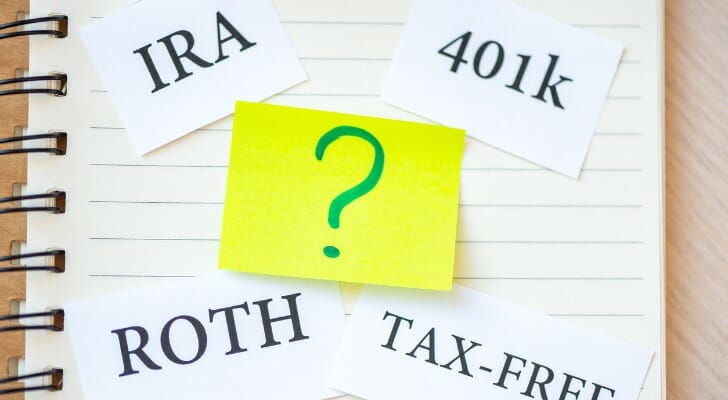Deciding between a traditional individual retirement account (IRA) and a Roth IRA can be difficult. Choosing when or if you should convert your IRA funds to a Roth account can be even more daunting. Experts commonly recommend that investors compare their current and future marginal tax rates to decide, but future tax rates can be highly uncertain and many investors are left wondering whether they made the right choice. Now, investment giant Vanguard has a more precise answer. Here’s how calculating your break-even point can pinpoint whether a Roth conversion makes sense for you.
A financial advisor could help you save for retirement and select investments that align with your financial goals. Find a qualified advisor today.
Vanguard Finds the Ideal Tipping Point for a Roth Conversion
Typically the rule of thumb is that Roth IRAs are most beneficial if an investor expects to be in a higher tax bracket upon retirement, since Roth contributions are taxed at the current rate and distributions are tax free. As such, Vanguard experts say that “assessing the current tax rate and expected future tax rate is a good first step” in determining whether you should convert your retirement savings to a Roth account.
However, sometimes a Roth conversion can be beneficial even if your future tax rate declines instead of increasing. So rather than a straightforward tax rate comparison, the firm recommends conducting a dynamic Break-Even Tax Rate (BETR) analysis to determine if a conversion is right for you. Calculating a BETR offers investors an approach that simplifies the decision-making process.
“If your future tax rate is at the BETR, conversion wouldn’t make a difference,” Vanguard analysts explain. “Simply put, the BETR shows how far your tax rate would have to fall to make conversion undesirable.”
If an investor’s future tax rate is higher than a calculated BETR, generally a Roth conversion would make sense financially. Even if an investor’s future marginal tax rate is lower than it is currently, certain scenarios can lower a BETR and make a conversion far more attractive than it would otherwise seem in a straightforward rate comparison. This could potentially save an investor thousands of dollars.
For instance, if you’re able to pay Roth conversion taxes from a taxable account, such as your standard brokerage account, the full value of your IRA can move to the Roth account. By not paying the conversion taxes from the IRA but with other portfolio funds, you can lower your BETR substantially. Vanguard calculates that, if an investor pays a current 35% marginal tax rate and expects to pay the same in retirement, converting to a Roth and paying taxes from a tax-efficient portfolio could lower the BETR to 29.6%. If taxes were paid from a tax-inefficient portfolio, where the investor has to pay annual taxes on investment returns, the BETR falls even further to 23.5%. As a result, a Roth conversion suddenly becomes rather appealing.
Another scenario where a BETR analysis helps is when an investor’s traditional IRA includes a non-taxable basis. When traditional IRAs are converted to Roth IRAs, only the pre-tax balance is subject to income tax. Vanguard research indicates that the greater the non-taxable basis, the lower the BETR, and the more advantageous a Roth conversion becomes. Similarly, when an investor opens a backdoor Roth and intends to contribute more to it over time, the BETR drops and makes a conversion even more beneficial.
How Retirement Savers Can Take Advantage
At its most basic, a BETR is the future tax rate at which the after-tax withdrawal value is equal in both a no-conversion and conversion scenario.
As an example, let’s say you’re currently a high-earner in the 35% marginal tax bracket and considering a $100,000 Roth conversion. You have 20 years left to retirement, at which point you expect to be in the 24% tax bracket.
First you calculate the no-conversion potential. You assume your $100,000 can triple over those 20 years if left in a traditional IRA, reaching $300,000. After subtracting 24% in taxes, the final after-tax withdrawal value of your funds will be $228,000.
Then you calculate the Roth conversion potential. Again, that same $100,000 can triple over 20 years. However, now you take the $35,000 that you pay in Roth conversion taxes (from your tax-inefficient portfolio) and estimate that, accounting for annual taxes on interest and capital gains, that $35,000 would have doubled over that same time period. As a result, the final after-tax withdrawal value after a Roth conversion would be $230,000.
Plugging those values into the Vanguard formula gives you a BETR of 23.3%: $300,000 * (1 – BETR) = $230,000.
In a straightforward rate comparison, you would not do a Roth conversion, since your current marginal tax rate of 35% is higher than your future tax rate of 24%. However, the BETR method indicates that it may actually be a good idea since the future rate of 24% is still higher than the calculated BETR of 23.3%. Of course, if you paid your Roth conversion taxes with the IRA funds and not from a separate brokerage account, the BETR would change and, in that scenario, a conversion may no longer make sense.
Bottom Line
Vanguard’s BETR analysis is a more precise method for determining whether an investor should consider a Roth conversion. Since it’s a dynamic number, affected by different financial decisions, calculating a BETR number allows investors to capture potential tax savings that a straightforward, traditional tax rate comparison might miss. Depending on the individual’s circumstances, it may be helpful to speak with an expert who can help you navigate the tax complexities of a Roth conversion, but tackling a BETR analysis yourself may be a solid place to start the process.
Retirement Planning Tips
- Not sure if a Roth IRA or Roth conversion can help you save more for retirement? For a solid financial plan, consider speaking with a qualified financial advisor. SmartAsset’s free tool matches you with up to three financial advisors who serve your area, and you can interview your advisor matches at no cost to decide which one is right for you. If you’re ready to find an advisor who can help you achieve your financial goals, get started now.
- Use SmartAsset’s free investment calculator to get a good estimate of how to grow your money over time.
Don’t miss out on news that could impact your finances. Get news and tips to make smarter financial decisions with SmartAsset’s semi-weekly email. It’s 100% free and you can unsubscribe at any time. Sign up today.
For important disclosures regarding SmartAsset, please click here.
Photo credit: ©iStock.com/Lusyaya, ©iStock.com/katleho Seisa, ©iStock.com/LaylaBird


